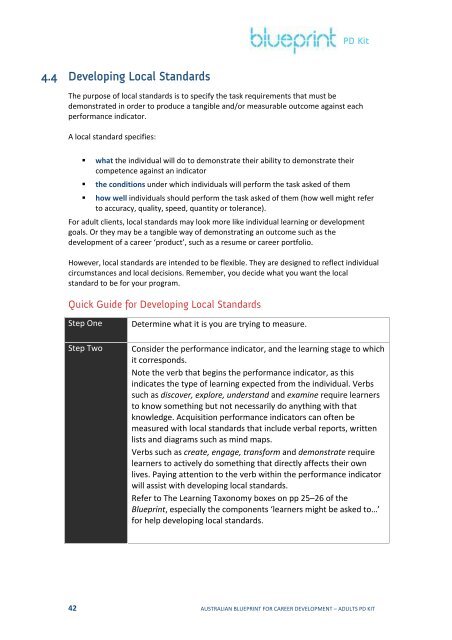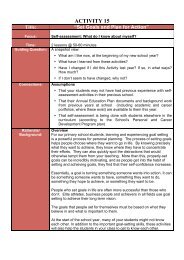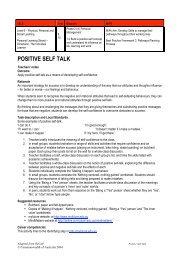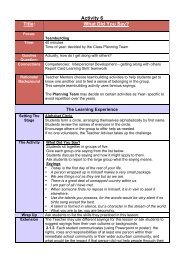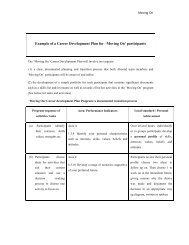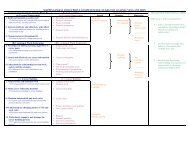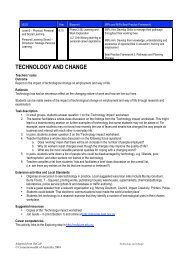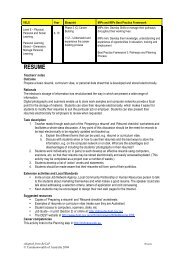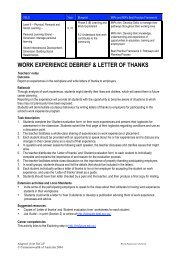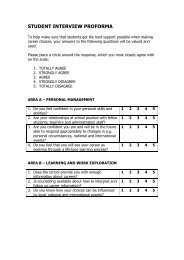Re-write of case studies - Blueprint - Australian Blueprint for Career ...
Re-write of case studies - Blueprint - Australian Blueprint for Career ...
Re-write of case studies - Blueprint - Australian Blueprint for Career ...
You also want an ePaper? Increase the reach of your titles
YUMPU automatically turns print PDFs into web optimized ePapers that Google loves.
PD Kit<br />
4.4 Developing Local Standards<br />
The purpose <strong>of</strong> local standards is to specify the task requirements that must be<br />
demonstrated in order to produce a tangible and/or measurable outcome against each<br />
per<strong>for</strong>mance indicator.<br />
A local standard specifies:<br />
• what the individual will do to demonstrate their ability to demonstrate their<br />
competence against an indicator<br />
• the conditions under which individuals will per<strong>for</strong>m the task asked <strong>of</strong> them<br />
• how well individuals should per<strong>for</strong>m the task asked <strong>of</strong> them (how well might refer<br />
to accuracy, quality, speed, quantity or tolerance).<br />
For adult clients, local standards may look more like individual learning or development<br />
goals. Or they may be a tangible way <strong>of</strong> demonstrating an outcome such as the<br />
development <strong>of</strong> a career ‘product’, such as a resume or career portfolio.<br />
However, local standards are intended to be flexible. They are designed to reflect individual<br />
circumstances and local decisions. <strong>Re</strong>member, you decide what you want the local<br />
standard to be <strong>for</strong> your program.<br />
Quick Guide <strong>for</strong> Developing Local Standards<br />
Step One<br />
Step Two<br />
Determine what it is you are trying to measure.<br />
Consider the per<strong>for</strong>mance indicator, and the learning stage to which<br />
it corresponds.<br />
Note the verb that begins the per<strong>for</strong>mance indicator, as this<br />
indicates the type <strong>of</strong> learning expected from the individual. Verbs<br />
such as discover, explore, understand and examine require learners<br />
to know something but not necessarily do anything with that<br />
knowledge. Acquisition per<strong>for</strong>mance indicators can <strong>of</strong>ten be<br />
measured with local standards that include verbal reports, written<br />
lists and diagrams such as mind maps.<br />
Verbs such as create, engage, trans<strong>for</strong>m and demonstrate require<br />
learners to actively do something that directly affects their own<br />
lives. Paying attention to the verb within the per<strong>for</strong>mance indicator<br />
will assist with developing local standards.<br />
<strong>Re</strong>fer to The Learning Taxonomy boxes on pp 25–26 <strong>of</strong> the<br />
<strong>Blueprint</strong>, especially the components ‘learners might be asked to…’<br />
<strong>for</strong> help developing local standards.<br />
42 AUSTRALIAN BLUEPRINT FOR CAREER DEVELOPMENT – ADULTS PD KIT


